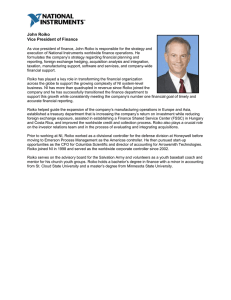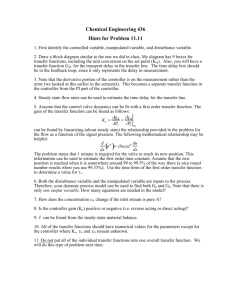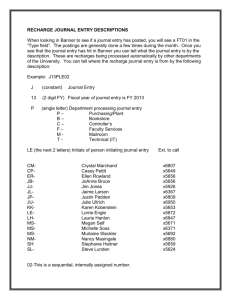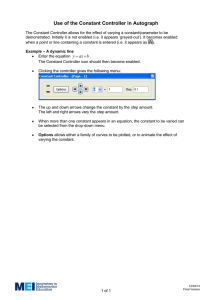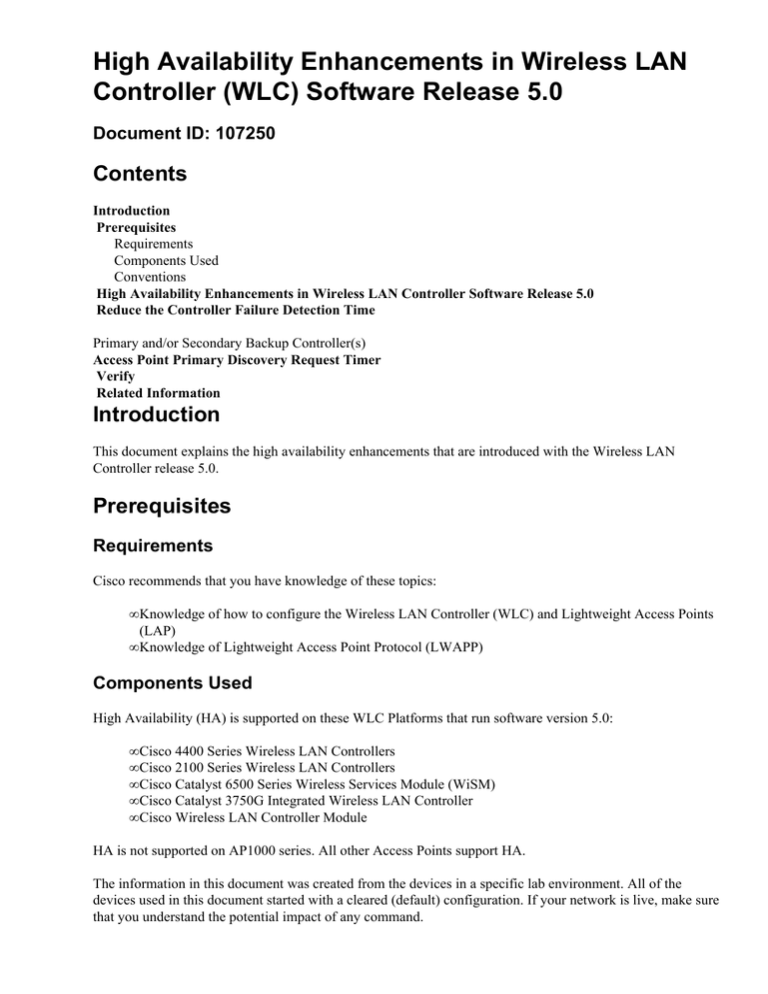
High Availability Enhancements in Wireless LAN
Controller (WLC) Software Release 5.0
Document ID: 107250
Contents
Introduction
Prerequisites
Requirements
Components Used
Conventions
High Availability Enhancements in Wireless LAN Controller Software Release 5.0
Reduce the Controller Failure Detection Time
Primary and/or Secondary Backup Controller(s)
Access Point Primary Discovery Request Timer
Verify
Related Information
Introduction
This document explains the high availability enhancements that are introduced with the Wireless LAN
Controller release 5.0.
Prerequisites
Requirements
Cisco recommends that you have knowledge of these topics:
• Knowledge of how to configure the Wireless LAN Controller (WLC) and Lightweight Access Points
(LAP)
• Knowledge of Lightweight Access Point Protocol (LWAPP)
Components Used
High Availability (HA) is supported on these WLC Platforms that run software version 5.0:
• Cisco 4400 Series Wireless LAN Controllers
• Cisco 2100 Series Wireless LAN Controllers
• Cisco Catalyst 6500 Series Wireless Services Module (WiSM)
• Cisco Catalyst 3750G Integrated Wireless LAN Controller
• Cisco Wireless LAN Controller Module
HA is not supported on AP1000 series. All other Access Points support HA.
The information in this document was created from the devices in a specific lab environment. All of the
devices used in this document started with a cleared (default) configuration. If your network is live, make sure
that you understand the potential impact of any command.
Conventions
Refer to Cisco Technical Tips Conventions for more information on document conventions.
High Availability Enhancements in Wireless LAN Controller
Software Release 5.0
In wireless network deployments that run controller versions earlier than 5.0, when a controller goes down, it
takes a long time for all the APs and the associated clients to move to a backup controller and for wireless
service to resume.
The features discussed in the document are implemented on the controller CLI in WLC software release 5.0 in
order to decrease the time that it takes for access points and their associated clients to move to a backup
controller and for wireless service to resume after a controller goes down:
• In order to reduce the controller failure detection time, you can configure the heartbeat interval
between the controller and access point with a smaller timeout value.
• In addition to the option to configure primary, secondary, and tertiary controllers for a specific access
point, you can now also configure primary and secondary backup controllers for a specific controller.
If the local controller of the access point fails, it chooses an available controller from the backup
controller list in this order:
♦ primary
♦ secondary
♦ tertiary
♦ primary backup
♦ secondary backup
• The access point maintains a list of backup controllers and periodically sends primary discovery
requests to each entry on the list. You can now configure a primary discovery request timer in order to
specify the amount of time that a controller has to respond to the discovery request of the access point
before the access point assumes that the controller cannot be joined and waits for a discovery response
from the next controller in the list.
Reduce the Controller Failure Detection Time
In order to reduce the controller failure detection time, new heartbeats are added between the WLC and AP
with smaller timeout values.
This feature is available in the CLI only if all advance timer configurations are done from the CLI:
In order to enable or disable the fast heartbeat timer and reduce the amount of time it takes to detect a
controller failure for local, hybrid−REAP, or all access points, issue the config advanced timers
ap−fast−heartbeat command.
config advanced timers ap−fast−heartbeat {local | hreap | all}
{enable | disable} interval
By default, this feature is disabled.
Examples
>
>
>
>
config
config
config
config
advanced
advanced
advanced
advanced
timers
timers
timers
timers
ap−fast−heartbeat
ap−fast−heartbeat
ap−fast−heartbeat
ap−fast−heartbeat
local enable 5
hreap enable 8
all enable 6
all disable
Primary and/or Secondary Backup Controller(s)
In addition to the option to configure Primary / Secondary / Tertiary WLCs on the AP side, a new
configuration on the WLC is introduced to set up primary and/or secondary backup controller(s).
If there are no primary/secondary/tertiary WLCs configured on the AP side and a primary backup controller
and/or secondary backup controller are configured on the controller side (downloaded to AP), the primary
backup controller and/or secondary backup controller are added to the primary discovery request message
recipient list of the AP.
In order to configure a primary backup controller for a specific controller, issue the config advanced
backup−controller primary command.
config advanced backup−controller primary
backup_controller_name backup_controller_ip_address
Example
> config advanced backup−controller primary Controller_1 10.10.10.10
In order to configure a secondary backup controller for a specific controller, issue the config advanced
backup−controller secondary command.
config advanced backup−controller secondary
backup_controller_name backup_controller_ip_address
Example
> config advanced backup−controller secondary Controller_1 10.10.10.10
Access Point Primary Discovery Request Timer
The access point maintains a list of backup controllers and periodically sends primary discovery requests to
each entry on the list. You can now configure a primary discovery request timer to specify the amount of time
that a controller has to respond to the discovery request of the access point before the access point assumes
that the controller cannot be joined and waits for a discovery response from the next controller in the list.
The existing primary discovery mechanism is enhanced to have the AP maintain the backup controller list.
The result of each primary discovery response is used to maintain the backup controller list.
In the event of WLC fail−over, the AP selects an available controller from its backup controller list in this
order:
• primary
• secondary
• tertiary
• primary backup controller
• secondary backup controller
It sends a join request directly to this selected backup controller and does not go back to the discovery
process.
Prior to WLC release 5.0, the primary request uses the same timer as the echo request, which is 30 seconds by
default. A new configuration is introduced that allows the primary discovery request to have a different timer
default, two minutes, and it is configurable.
In order to configure the access point primary discovery request timer, issue the config advanced timers
ap−primary−discovery−timeout command.
config advanced timers ap−primary−discovery−timeout interval
The default time interval is 120 seconds.
Examples
> config advanced timers ap−primary−discovery−timeout 1200
Verify
You can issue this show command in order to verify which advanced timers are configured.
show advanced timers
Here is an example:
(Cisco Controller) >show advanced timers
Authentication Response Timeout (seconds)........
Rogue Entry Timeout (seconds)....................
AP Heart Beat Timeout (seconds)..................
AP Discovery Timeout (seconds)...................
AP Local mode Fast Heartbeat (seconds)...........
AP Hreap mode Fast Heartbeat (seconds)...........
AP Primary Discovery Timeout (seconds)...........
10
1200
30
10
2 (enable)
2 (enable)
30
Note: The timers in bold do not appear in the earlier versions. Here is a sample output from WLC version 4.2:
(Cisco Controller) >show advanced timers
Authentication Response Timeout (seconds)........
Rogue Entry Timeout (seconds)....................
AP Heart Beat Timeout (seconds)..................
AP Discovery Timeout (seconds)...................
10
1200
30
10
Issue this show command in order to verify which backup controllers are configured:
show advanced backup−controller
Here is an example:
(Cisco Controller) >show advanced backup−controller
AP primary Backup Controller .................... WLC−2 10.10.78.2
AP secondary Backup Controller .................. 0.0.0.0
From the console of the AP connected to the WLC, you can see the HA configuration if you issue the show
lwapp client ha and show lwapp client config commands.
AP1240#show lwapp client ha
fastHeartbeatTmr(sec)
primaryDiscoverTmr(sec)
primaryBackupWlcIp
primaryBackupWlcName
secondaryBackupWlcIp
secondaryBackupWlcName
DHCP renew try count
Fwd traffic stats get
Fast Heartbeat sent
Backup WLC array:
Index [3] System name
Index [3] IP
Index [3] Aging Count
2 (enabled)
30
0xA0A4E02
WLC−2
0x0
0
302048
281606
WLC−2
0xA0A4E02
0
AP1240 #show lwapp client config
configMagicMark
0xF1E2D3C4
chkSumV2
21720
chkSumV1
24798
swVer
5.0.72.0
adminState
ADMIN_ENABLED (1)
name
AP1240−Edgewood
location
default location
group name
mwarName
10.10.76.2
mwarName
10.10.78.2
mwarName
numOfSlots
2
spamRebootOnAssert
1
spamStatTimer
180
randSeed
0x28F4
transport
SPAM_TRANSPORT_L3 (2)
transportCfg
SPAM_TRANSPORT_DEFAULT(0)
initialisation
SPAM_PRODUCTION_DISCOVERY(1)
ApMode
Local
Discovery Timer
10 secs
Heart Beat Timer
30 secs
Led State Enabled
1
AP ILP Pre−Standard Switch Support Enabled
AP Power Injector Override Safety Checks
Configured Switch 1 Addr 10.10.76.2
non−occupancy channels:
Ethernet (Duplex/Speed) auto/auto
Related Information
• Cisco Wireless LAN Controller Configuration Guide, Release 6.0
• WLAN Controller Failover for Lightweight Access Points Configuration Example
• AP Load Balancing and AP Fallback in Unified Wireless Networks
• Wireless LAN Controller and Light Weight Access Points Failover Outside the Mobility Group
Configuration Example
• Technical Support & Documentation − Cisco Systems
Contacts & Feedback | Help | Site Map
© 2014 − 2015 Cisco Systems, Inc. All rights reserved. Terms & Conditions | Privacy Statement | Cookie Policy | Trademarks of
Cisco Systems, Inc.
Updated: Dec 03, 2009
Document ID: 107250

